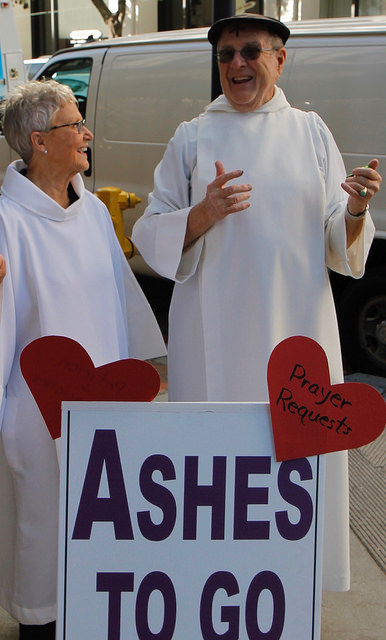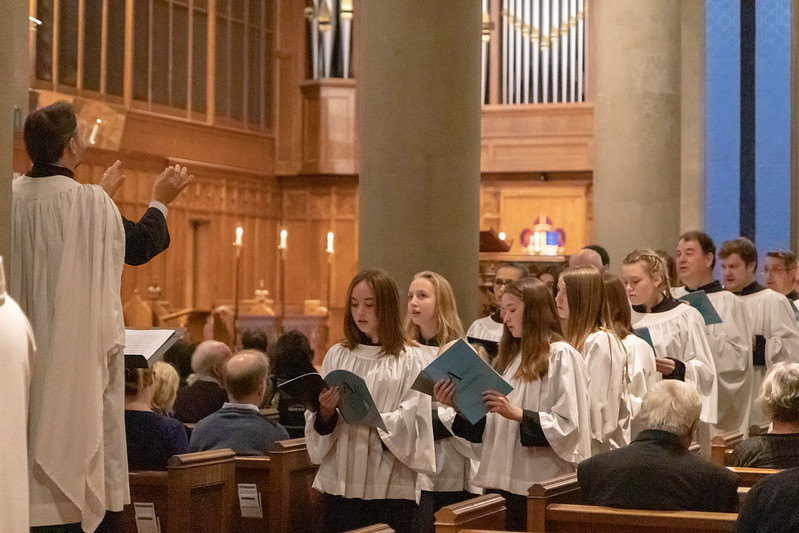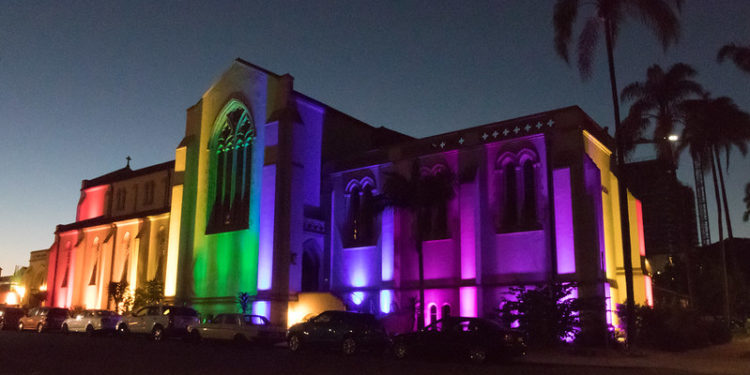By Albert H. Fulcher
Throughout 2019, St. Paul’s Cathedral has celebrated 150 years in San Diego with several events including musicals, worship services, visits to historic sites and special guests. Those celebrations culminate with its final event for the year, Gala 150, which will be held at the cathedral on Dec. 13.

The Very Reverend Penny Bridges said that St. Paul’s has grown significantly and is now known as a place that is welcoming and inclusive to everybody, without exception.
“The job of a cathedral is to be available for the bordering community and to be there for the city,” Bridges said. “We think of ourselves as the cathedral for the city. When we started planning our 150th celebration, one of the things we wanted to do was to have some aspect of it involve people from around the city.”
Mayor Kevin Faulconer will be there, and the first lady of San Diego, Katherine Faulconer, is the honorary co-chair of the event. Bridges said that it has many representatives from various city organizations and nonprofits supporting the gala including The Society of St. Paul, The Reverend Canon Michael Kaehr, the Imperial Court de San Diego, Marie Tuthill, Jen Jow, Greystar and insideOUT, and many other local organizations.
“There will be 300 seats and it is sold out,” Bridges said. “Not only is it a spectacular celebration in itself, but it is a fundraiser to raise seed money for us to convert part of our property to a drop-in center where we can serve our neighbors that live outside and are unsheltered. We are right next to Balboa Park and there are hundreds of people who call Balboa Park home.”
 Bridges explained that over the last five years, St. Paul’s started offering showers twice a month, a hot breakfast and it has now become a community event and gathering time. Bridges said outreaching to the homeless is the outward-looking cause that St. Paul’s hopes will benefit from the gala.
Bridges explained that over the last five years, St. Paul’s started offering showers twice a month, a hot breakfast and it has now become a community event and gathering time. Bridges said outreaching to the homeless is the outward-looking cause that St. Paul’s hopes will benefit from the gala.
“We’ve been borrowing shower units to do that, but our plan is to create a center underneath our chapel with permanent showers,” Bridges said. “When our turn comes around with the Interfaith Shelter Network, once a year each church takes two weeks and offers overnight shelter and meals for 12 people who are homeless and in transition. We’ll have a designated space where those people can sleep when it is our turn. If there is really terrible weather, we can open it up for those who are outside.
“The gala is kind of historic because we are removing all the pews from the church. That’s a big deal,” Bridges continued. “We are having a black-tie dinner event in the cathedral itself. There will be round tables, gold chairs, purple and gold light show, musical entertainment and the keynote speaker is a woman who was the first female presiding bishop of the entire Episcopal Church, The Right Reverend Katharine Jefferts Shori. Katherine is a historic figure in her own right, elected in 2006. The Episcopal Church is not only in the United States, we have a presence in more than 19 countries. Bishop Katherine is an extraordinary, unique figure. She was a marine biologist before she was a priest. That’s two very distinguishing careers.”
Not only is St. Paul’s hosting this black-tie dinner in the cathedral, but it is also throwing an after-party for those who could not manage to get tickets for the dinner. People are welcome to come and dance to disco music in The Great Hall after dinner and have desserts and wine. The after-party, Club 150, is from 9-11:30 p.m. and is $95/person or $150 for couples.
“We are opening this up to more people this way,” Bridges said. “Tickets will be available at the door for that. We’re trying to do a little bit of everything. Mariachi Mi San Diego, Grupo Folklórico Herencia Mexicana, Roman Palacios, classical guitarist Anthony Cutietta and disco.”
The Right Reverend Susan Brown Snook, bishop of the Episcopal Diocese of San Diego (whose home is St. Paul’s Cathedral), said that the reach of the diocese covers from South Bay, up to Hemet, Temecula, east to Palm Springs and the Palm Desert and southeast all the way to Yuma, Arizona. Snook was ordained this year in June at the cathedral.
“The cathedral is a leader for us in the sense not only liturgically in its worship life, but it is also a leader in the wider community in San Diego,” Snook said. “Because it is passionately committed to the diversity and inclusion of all people, it has been a leader in supporting women leadership in the church. Penny is the first female dean of the cathedral and I am the first female bishop of this diocese. It is also a leader in the wider community in interface and ecumenical relationships.”
Snook said that cathedral folks work closely with other religious leaders in this area to promote shared religious values of justice, care and compassion for all people. The cathedral has also been a leader in its wider church in this region in supporting LGBTQ equality and it is widely known in this city for its commitment to justice for all people.
 “A 150th anniversary is a momentous event in the history of the church and the history of San Diego,” Snook said. “It is a great time for us to step back, see where we’ve been and how the cathedral has been a leader in this community, and how it has led our wider church in ministry not only with Episcopalians but people in the city.”
“A 150th anniversary is a momentous event in the history of the church and the history of San Diego,” Snook said. “It is a great time for us to step back, see where we’ve been and how the cathedral has been a leader in this community, and how it has led our wider church in ministry not only with Episcopalians but people in the city.”
“The gala will be a wonderful event because it will benefit people in need and it will also truly allow us to celebrate what the cathedral is and what we believe our church is called to be in our ministry, which is a beacon of light for those who need light,” Snook continued.
Bridges said for San Diego, St. Paul’s is pretty old, but by European cathedral standards, it is just a newborn. St. Paul’s was founded before San Diego was San Diego.
The very first Episcopal service was held in 1853, at the Court House. In the 1850s and 1860s, there was an Episcopal diocese looked after by a bishop that covered the entire state of California.
“The bishop at that time sent a priest [Reverend Sidney Wilbur] to San Diego who held a service in Old Town in 1869 and they started using an old barrack that had been abandoned,” Bridges said. “So, a little congregation started up on Dec. 18, 1869, for its first service. It was the beginning of any Episcopal presence in San Diego and the first Protestant churches in the area.”
St. Paul’s is now the fourth-oldest incorporated Episcopal congregation in the state. The parish started to grow from its beginnings in Old Town and when originally founded, it was called Holy Trinity Parish — and then changed its name to St. Paul’s in 1887. The first church building on the corner of Sixth Avenue and C Street was given to St. Paul’s by Alonzo Horton, the father of the city.
“In 1919, the congregation bought the five-lot site where we stand now,” Bridges said. “The first thing they built on this site is what we now call The Great Hall, dedicated in 1928. In the dedication speech it says, ‘These structures were intended to be monumental in their character, of the sort indeed to exemplify an enduring form, the aspirations of the faith of our people.’”
People worshiped in The Great Hall for several years and in 1951, they started building the church. It took the entire year to build with its first service in December 1951.
“There’s a pretty strong tradition that cathedrals are never finished,” said Bridges. “St. Paul’s was not a cathedral when it was built, but indeed, it has never been finished. It was finished as much as it ever has been in 1967. There was a plan to put on a tower and also a transept where you bump out the sides to make a cross-shaped church. St. Paul’s has one side bumped out on the south but never got the north transept built. So, we are a little bit asymmetrical.”
The church was designed by the same architect who designed the Washington National Cathedral in Washington D.C., American architect Philip Hubert Frohman.

Over the intervening years, the Diocese of California began to split up, and in 1974, the Diocese of Los Angeles created the Episcopal Diocese of San Diego. In 1985, St. Paul’s Church was designated as the new cathedral for the diocese. “Cathedral” is a Greek word that means “seat.” The cathedral has a place where the bishop has his or her seat.
“A cathedral is sort of a mother church for the diocese and where a bishop has a home. Though, the nature of a bishop’s job is that they are very rarely at home,” Bridges said. “Since it became a cathedral, there have been four deans. A dean is just an Episcopal word for a senior pastor. I am the fourth. Our first dean is still around [The Very Reverend James Earle Carroll]; he’s 90 years old and very much beloved, and until very recently, very active.”









